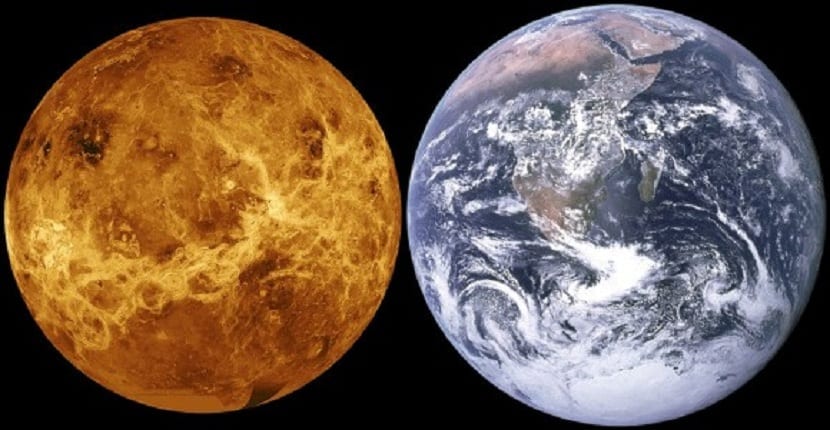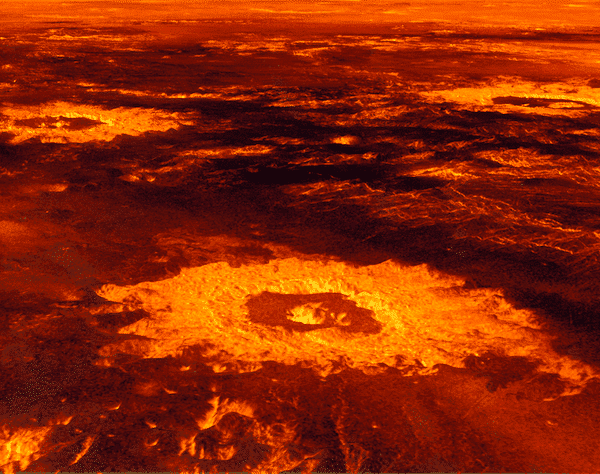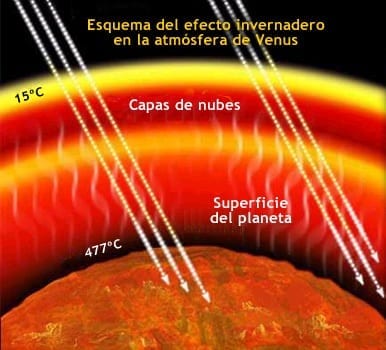
The planet Venus it has a climate that has varied over time due to the relationships between its interior tectonic activity and atmospheric changes. It is closer to the Sun than our planet is. This causes their temperatures to be much higher than those of planet Earth.
Earth and Venus were almost the same size and compositionHowever, their evolutionary trajectories were directed differently until they became two totally different planets. Has there been a climate change on the planet Venus?
Venus, the planet hell
The temperature on the surface of the planet Venus It is about 460 ° C compared to our 15-17 ° C on average on Earth. This temperature is so high that it makes the rocks glow in the eyes of anyone looking at them. The planet is dominated by a deadly greenhouse effect, maintained by an atmosphere whose main component is carbon dioxide. There is also no liquid water on the planet, obviously it would evaporate since the boiling point of water is 100 ° C.
In addition to the above, the conditions of the planet create an atmospheric pressure which is almost double that of ours. Instead of being composed of water vapor, its clouds are composed of sulfuric acid.

Until recently, there was little information on the evolution of the planet Venus because its sulfuric acid clouds did not allow us to see terrestrial processes, such as volcanism or tectonics. However, for the last 56 years, thanks to 22 space probes who have photographed, explored, analyzed and stepped on Venus, we can learn more about it.
The photographs of the probes reveal that Venus is a planet that has experienced huge volcanic eruptions and that, almost certainly, are still active. These discoveries suggest to what extent the Earth's climate is unique, since we can ask ourselves why, if very similar forces were involved in the formation of both planets, there were totally different effects on Earth and a totally misguided evolution. other.
Scientists regard this evolution so disparate to the privileged situation we have in our solar system and our position with respect to the Sun. What use can we get from knowing the evolution of the climate of other planets if we do not live in them? Well the answer is simple, with the increasing volume of waste, industrial society and greenhouse gas emissions into the atmosphere we are modifying our climate. If we can identify what factors determine the evolution of the climate on other planets, we can understand the natural and anthropogenic mechanisms that alter our climate.
Climate and geology of Venus vs Earth
One of the causes of the variability of the Earth's climate lies in the nature of its atmosphere, a product of the continuous exchange of gases between the crust, mantle, ocean, polar caps and outer space. The engine of geological processes, geothermal energy also drives the evolution of the atmosphere. Geothermal energy is released mainly with the decay of the radioactive elements inside. But it is not so easy to explain the loss of heat in solid planets. The two main mechanisms involved are: volcanism and plate tectonics.

As far as the Earth is concerned, its interior has a conveyor belt system associated with plate tectonics. Whose continuous recycling of gases has exerted a stabilizing force on the Earth's climate. Volcanoes pump gases into the atmosphere; the subduction of lithospheric plates return it to the interior. While most volcanoes are associated with plate tectonic activities, there are notable volcanic structures (such as the Hawaiian Islands formation) that have formed "hot spots" independent of the contours of the plates.
Craters and plate tectonics
What happened on Venus? Plate tectonics, if involved, will be on a limited scale; At least in the recent past, heat was exchanged by the eruption of vast basaltic lava plains and later by volcanoes formed above them. Understanding the effects of volcanoes constitutes The obligatory starting point for any approach to the planet's climate.
The scarcity of impact craters on Venus, although its atmosphere is enough to protect the planet from small incident objects, large craters are missing. This is also felt on Earth. The action of wind and water has determined to erode ancient craters. But the surface of Venus registers such heat that it prevents the existence of liquid water; also, the surface winds are quite light. Without eruption the processes that alter and, in the long run, The impact craters will be erased by volcanic and tectonic activities.

Most of the craters on Venus appear recent. Where did the ancient craters go, if most of the ones that remain have not been disturbed? If they have been covered by lava, why aren't more partially covered craters visible, how did they disappear without randomly losing their original placement?
The theory most accepted by the scientific community is that widespread volcanism erased most impact craters and created vast volcanic plains 800 million years ago, which was followed by a moderate level of incessant volcanic activity until today.
Forms of water on the surface of Venus
We distinguish, first of all, various curious linear structures that are reminiscent of soils tilled by water. They are the living picture of our rivers and flood plains. Many of these structures end in delta-like ejection channels. The extreme dryness of the environment it makes the waters unlikely to excavate these accidents.

Why are they then? Maybe, calcium carbonate and calcium sulfate and other salts are the culprits. The lavas loaded with these salts melted at temperatures a few tens to a few hundred degrees higher than the current surface temperatures of Venus. In the past, a somewhat higher surface temperature could have spilled fluid lava rich in salts on the surface, whose stability would explain the forging action of the accidents that we see today.
Evidence of the change in climate of Venus
Greenhouse effect and gas concentration
We have to keep in mind that greenhouse gases allow sunlight to reach the surface of Venus, but blocks emitted infrared radiation. Carbon dioxide, water, and sulfur dioxide each absorb a particular wavelength band of the electromagnetic spectrum. If it weren't for those gases, solar and infrared radiation would balance at a surface temperature of about 20 degrees.
The water and sulfur dioxide that volcanoes release into the atmosphere are then removed. Sulfur dioxide reacts well with carbonates on the surface, while ultraviolet solar radiation dissociates water.

Cloud cover and temperature
Sulfuric acid clouds vary in thickness after a global series of volcanic eruptions. First, the clouds thicken as water and sulfuric acid are thrown into the air. Then they lose it as the concentration of these gases decreases. Elapsed about 400 million years from the beginning of volcanism, acid clouds are replaced by tall, thin water clouds.
Climate variations on Venus
Cracks and folds furrows the planet. Some of these configurations, at least the wrinkled ridges, may be related to temporary variations in climate. The theory shows that the strange and hostile environmental conditions are maintained due to complementary properties of the constituents of the atmosphere. Water vapor, even in trace amounts, It absorbs infrared radiation at wavelengths that carbon dioxide does not.
At the same time, sulfur dioxide and other gases block the wavelengths. Taken together, these greenhouse gases make the atmosphere of Venus partially transparent to incident solar radiation, but almost completely opaque to emitted infrared radiation. Consequently, the surface temperature is triple that of the planet without an atmosphere. By comparison, the Earth's greenhouse effect today raises the temperature of the Earth's surface only 15%. If it was true that volcanoes crossed the surface of Venus 800 million years ago, They must have also dumped a huge amount of greenhouse gases into the atmosphere in a fairly short time.
A model of the planet's climate has been developed that includes the release of gases by volcanoes, the formation of clouds, the loss of hydrogen in the upper layers of the atmosphere, and the reaction of atmospheric gases with minerals on the surface. Between these processes a subtle interaction develops that cools the planet. Faced with such conflicting effects it cannot be decided what the injection of the two gases meant for the global climate of Venus.
That is why, as a conclusion, we can say that there was a climate change on Venus, but we do not know to what extent the gases could act in their changes.